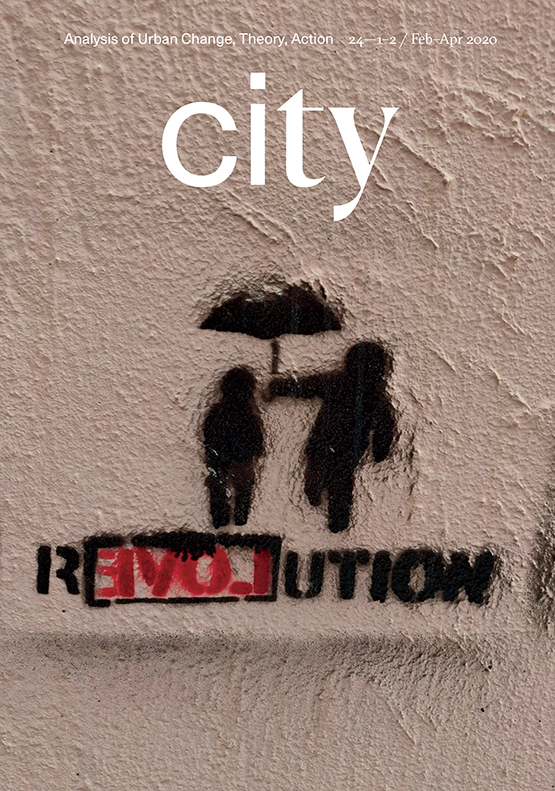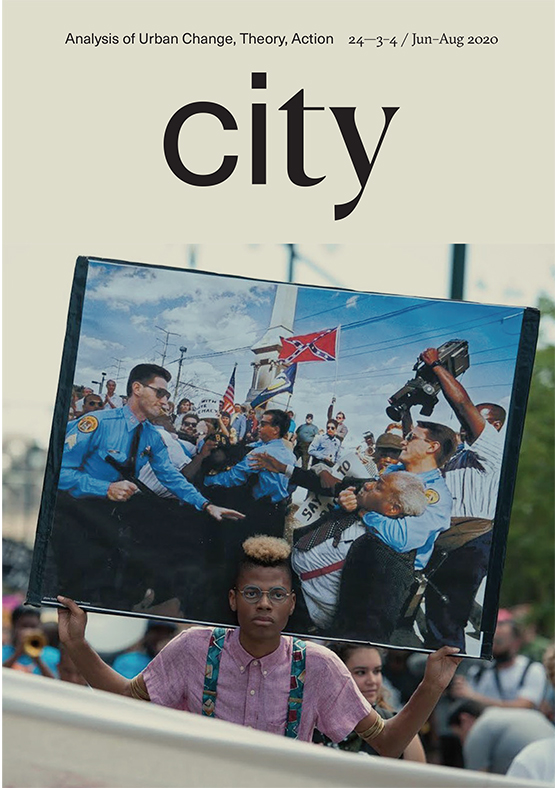founding editor: bob caterrall
editor: city editors
editorial: For the City yet to come, by Andrea Gibbons,Anna Richter,Antonis Vradis,David Madden,Debbie Humphry,Melissa Fernández ArrigoitiaORCID Icon &Michele Lancione
The journal that you hold in your hands, these words coming up on your screen, are the work of a large number of people that gathered together to begin a new era for a publication that we and many others have cherished in the past decades. To some extent, it’s business as usual: research is done; papers are produced, read, reviewed and edited, then published behind the walls of a multinational enterprise, which turns them into a private affair to be sold to libraries worldwide and finally handed over to you, if you are lucky enough to work in a place that can pay for access. We weren’t able to change that (though we remain committed to the significant victory of a reasonably affordable annual subscription rate for those outside the academy). But we are committed to solidly reworking it from within. To do so, we require a new culture in researching, writing and debating cities and the knowledge production that takes place in, about and around them. Building on City’s two and a half decade history of engaged scholarship and commentary, we believe that a journal can play a role in building up a collaborative critical culture and fostering its power of dissonance. City is dedicated to radical analysis and cutting-edge scholarship. But it is also an exercise in opening a space within urban studies and practice to allow for a multitude of voices to come through and be heard.
For these reasons, this new iteration of City is our attempt to compose new variations while staying close to the original tune. Bob Catterall founded City in 1996, building on its predecessor, Regenerating Cities. The new journal’s first editorial began with a series of questions: What is a city in the late twentieth century? And, just as important a question, what could and should it be? When? Where? How?’ From its first words, City sought to combine the empirical with the propositional, not only seeking to understand what urban life is but also seeking to understand what it could become. Bob Catterall and his comrades and associates wanted the journal to engage with how cities—and in particular London—were changing at a time of rapid restructuring, and also to question urban studies as it had been practiced. This meant developing a new kind of journal that was both of and beyond the academy. The question of standpoint, of speaking from a distinct perspective, and standing for something, has always been central to the journal’s ethos. The first editorial answers its initial questions with further questions:
How can we establish adequate answers to these questions? And who are ‘we’? We are academics, architects, community activists, film-makers, journalists, people who have worked in or with local government, planners–a scattering of like-minded people and networks across a number of countries … . A principal aim of City is to foster that mutuality and sense of collection purpose.
From the beginning, City sought to bring a new version of urban studies into existence. Seeking to rework urban studies as a critical and radical enterprise, the journal’s contributors, editors, reviewers and supporters built the publication around the fundamental refusal to dissociate theory and practice. City has always been about analysis and action. It has been committed to understanding urban trends, culture, theory and policy so that they might be changed. This commitment brought the journal into newsstands, radical bookshops, squats and other corners where the academy generally does not go. City has always ventured beyond and always refused a separation of the academic from the political. The journal’s editors and contributors have been unapologetically committed to a kind of scholarship and praxis that seeks to challenge and change the unjust, unequal urban world.
The journal now has a new structure and new appearance, but we intend it as a reaffirmation of this original, essential City project. Along with City’s wider editorial contributors, we have worked hard in the past 2 years to move the journal into a new phase, changing what needed to be changed while maintaining its radical commitments. We wanted the journal to be collectively run to better embody its critical and open spirit, and to continue to cultivate the solid links with the broader community that has done so much for it in the past years. So we came up with a simple structure of a collectively run editorial board: the City Editors, who manage the journal on a day-to-day basis, and a larger group of committed scholars: the City Collective, who shape the project more broadly—contributing content, crafting strategy, offering insight, proposing projects and stepping up as needed to help with the management of this beast. Running a journal is hard work, and we definitely still have a lot to learn, but we are both privileged and proud of what we have been able to contribute so far: working through a back-log of papers, devising this re-launch and dreaming of exciting new endeavours that you will read about in these and forthcoming pages. We have restyled the appearance of both the journal and City’s website (www.city-analysis.net) to strengthen the visual coherence, impact and readability.
At the centre of this new organisational structure and appearance, however, is what really matters: what we publish. In the City tradition, our project is to confront the urban critically—which means, as Peter Marcuse wrote in these pages, to not take things for granted. This can be done in a multiplicity of ways. City insists on being critical, but never has had and will never have an orthodoxy. For political economy, radical black and critical disability scholarship, for feminist, queer, decolonial and post-structuralist thinking and for a variety of combinations thereof and outwith, City is the home of urban analysis that refuses to separate theory and practice, writing and action, the academic and activist, the rigorous and the creative. City is a home for radical thinking, but not a stable one; rather a home that is contested from within and open to without, always seeking to expand its boundaries, geographically and intellectually. This means expanding the places and voices that appear in its pages. And it means returning to the vision of City as a space not only for academics and researchers but also for activists, artists, practitioners and concerned city-dwellers, all trying to make sense of their built environment and social struggles.
To borrow a phrase from AbdouMaliq Simone, we want you to be part of the City yet to come. We are relaunching the journal so that it can be a home for new urban ideas and arguments that have not yet been born. We are planning exciting projects to further shake things up, including cross-pollination across languages, journals and countries, with more open-access content; as well as revamping our website to build on the interviews, reviews, rapid response features, audio-visual content and dialogues to create new forms and engage an ever wider audience within and beyond the academy. We are also working towards the creation of City-run workshops and summer schools, to be held in urban spaces beyond the island where many of us Editors live. We want to work with contributors and readers in cities across the world and, in this spirit, to repopulate the Editorial board. For that we need you. We welcome your feedback on everything we have done so far and, most importantly, we want you to become part of the journal and work with us to make it better, stronger, braver—to strengthen its collaborative and critical intent. The Collective is open and invites you in.
This first issue of the relaunched City is therefore a collective statement of intent. A partial, unfinished, open and joyful attempt at crafting a different kind of academic publication. We are very excited to have artists and scholars, activists and storytellers, young and old, experienced and early career, from the four corners of the world. We would have liked to have even more, and we are sorry we couldn’t include all, but this is only the beginning. We need you to help us reach the cities, communities and movements that we have not accessed.
The commissioned contributions to this double issue address a range of problematic issues and themes, but also propose different ways of thinking the city and beyond. The five sections are suggestions rather than definite delineations, and most papers actively defy the boundaries and borders of even the broadest categorisations. Something we continue to encourage in the pages of City. Environmental futures is the shared, urgent concern highlighted in the pieces authored by Linda Etchard and Leo Cerda; Ulises Moreno-Tabarez; Margit Mayer; Daniel Aldana Cohen; Sarah Knuth; and Marcelo Lopes de Souza. They offer thoughts on the challenges for critical urban theory and studies from a range of different perspectives and geographies.
to read this editorial in full, please click here.




